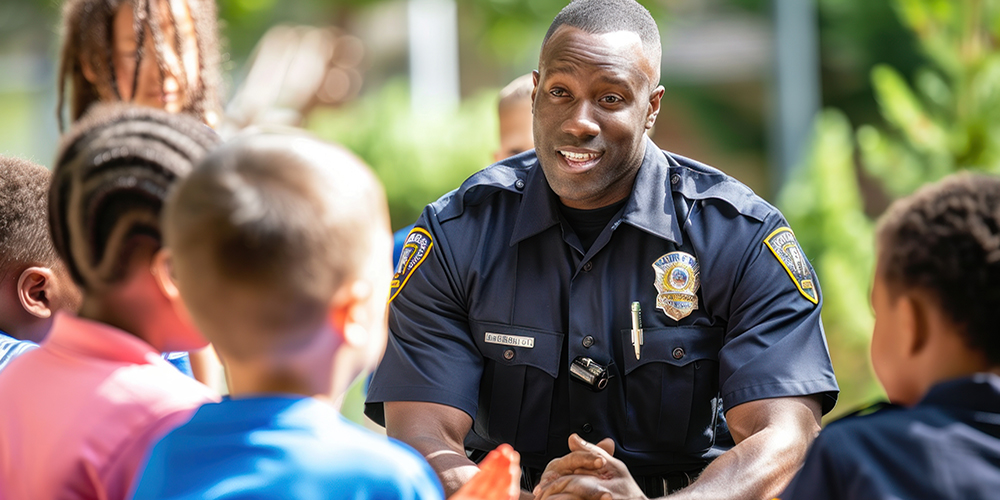There’s no doubt that safety in schools is essential for the success and well-being of students, faculty, and the community at large. Yet, recent statistics highlight a troubling reality: In the 2021-2022 school year, 67% of all public schools recorded at least one violent event, and 2023 witnessed a tragic record of 349 school shootings.
With these figures in mind, it’s evident why fears of violence plague schools, and why maintaining a safe educational environment is more pressing than ever. Given these rising safety concerns, school resource officers (SROs) on campus can significantly improve feelings of security in learning environments. By building meaningful relationships and establishing trust within the school community, SROs promote safety, reduce violence, and support at-risk students and the campus as a whole. Their role not only addresses immediate threats but also works towards creating a safer environment for everyone in the school community.
The Role of a School Resource Officer
An SRO is a sworn law enforcement officer assigned to work within a school setting to ensure safety and prevent crime. Their approach emphasizes the use of non-disciplinary methods to address any issues that arise, with arrests being a last resort. In addition to crime prevention, SROs serve as educators, emergency managers, and mentors. This positions them as both leaders and protectors on school grounds, who can positively influence student behavior and outcomes.
At the core of an SRO’s role is building trust with the campus community. This is essential for creating a culture of safety, where students feel comfortable with their presence and respect their role. By becoming a trustworthy resource, SROs can better encourage students to approach them with concerns or to report harmful behavior, allowing them to be even more effective at enhancing school security.
Here are three ways school resource officers can build trust with the campus community.
1. Establish an Open-Door Policy
For SROs, a key element in building strong relationships within a school community is acting as an accessible resource. One of the most effective strategies for SROs to do this is by maintaining an open-door policy, resulting in enhanced approachability and making it easier for students to engage with the SRO. An open-door policy allows students to come to the SRO with questions or concerns, or simply to get to know them better — creating more avenues for support.
RELATED ARTICLE: How Brentwood Union Community Relations Officers Serve and Protect Students
By making themselves available, SROs can engage in casual conversations with students, learning more about their lives and interests outside of crises. Students are more likely to discuss serious issues with faculty members they trust, so for SROs, accessibility is needed to create these strong relationships. These interactions contribute to building rapport and trust as students see the SRO as someone genuinely interested in their well-being rather than just an enforcer of rules. When students see that SROs are consistently approachable and willing to help, it reinforces their sense of security and connection with the officer. This informal engagement helps break down barriers, building a sense of familiarity and comfort.
Maintaining an open-door policy is equally important for interactions with faculty members. Teachers and staff are on the front lines of observing student behavior and may have valuable insights or concerns about individual students who might need help that they cannot provide alone. By collaborating with teachers, and being available to discuss these concerns, SROs can work together with faculty to develop solutions and provide support. This collaborative approach reinforces the SRO’s role as a partner in promoting the overall well-being of the school community.
2. Engage with Students in the Classroom
Actively participating in various educational settings is another effective way for SROs to establish positive visibility for themselves within the school. By involving themselves in classroom discussions, they can share their expertise and experience in subjects related to health, psychology, or social studies with valuable on-the-job insights related to topics like safety, mental health, and the justice system.
Additionally, highlighting different career opportunities in the public safety industry can inspire students and broaden their understanding of an SRO’s role within the community. In turn, this helps to address the recruiting issues faced by the public safety industry in recent years.
RELATED ARTICLE: Police Officer Hiring Increased in 2023
Sharing personal experiences in the classroom setting and answering students’ questions helps humanize SROs, who may initially seem intimidating to those unfamiliar with them. By openly discussing their experiences and challenges, SROs can become relatable mentors who students feel comfortable talking to. These face-to-face interactions also help break down barriers and allow for ongoing dialogue about students’ perceptions of safety on campus, making them more comfortable seeking help and guidance in the future. Through these interactions, students gain a better understanding of the complexities and responsibilities of the SRO role, creating a greater sense of respect and trust.
Expanding their involvement beyond traditional security roles allows SROs to be seen as mentors and educators, reinforcing their role as valuable members of the school community. When SROs actively participate in students’ educational experiences, they can leave a positive impact on how police officers are perceived and contribute to the overall sense of safety on school grounds.
3. Be Visible on School Grounds
Establishing a presence throughout all parts of a school campus is a necessary aspect of creating a predictable support system for students. Being available to engage with members of the school community in informal settings like hallways, cafeterias, and during events allows SROs to naturally build rapport by showing a genuine interest in students’ lives, both in and outside of school. This informal interaction not only helps students feel more comfortable around SROs but also provides the SROs with insights into students’ lives and concerns.
As the main safeguard of campus, SROs also have the opportunity to monitor for potential issues before they escalate. Their regular presence allows them to address and identify warning signs early, potentially preventing a crisis from happening. There have been numerous instances of SROs intervening to prevent or quickly mitigate active school shootings, demonstrating that this proactive approach not only enhances school security but also shows students that their well-being is the SRO’s priority.
RELATED ARTICLE: 9 Common Traits of Autism SROs Should Know to Foster Positive Student Interactions
SROs can act quickly in emergencies, coordinating with other law enforcement personnel and school officials to manage situations and minimize any harm. By also leading and participating in regular drills and training exercises, SROs can also ensure that they and the school community are prepared for various emergency scenarios.
When the school community sees an SRO consistently taking an active interest in their well-being and their safe learning experience, it reinforces the SRO’s role as a dedicated and reliable resource. This ongoing visibility, vigilance, and engagement contribute to a positive perception of SROs, enhancing their effectiveness in maintaining a safe and supportive campus and being a protector of their community.
Conclusion
Many schools and districts consider SROs an essential component of their safety strategies, but to be effective, SROs need to work to build and maintain the trust of their community. By enhancing campus-wide preparedness and positioning themselves as a central campus figure in security and crisis management, SROs can significantly improve concerns about violence at schools.
Creating a sense of trust and visibility is key to the success of SROs in their role. Through open communication, active engagement, and a consistent presence, SROs can work to enhance overall school security and improve the well-being of everyone on campus. By doing so, they help ensure that schools remain places of learning, growth, and safety, where students, faculty, and the community can thrive in a secure and supportive environment.
Doug Kazensky is a former police training sergeant and officer of 24-plus years and Senior Solutions Engineer at Vector Solutions. After proudly serving in the United States Air Force as a member of the Security Police, he joined the Longview Police Department in Washington in December 1997. He served in patrol, as a School Resource Officer (SRO), and as a detective specializing in fraud and computer crimes.
Note: The views expressed by guest bloggers and contributors are those of the authors and do not necessarily represent the views of, and should not be attributed to, Campus Safety magazine.







